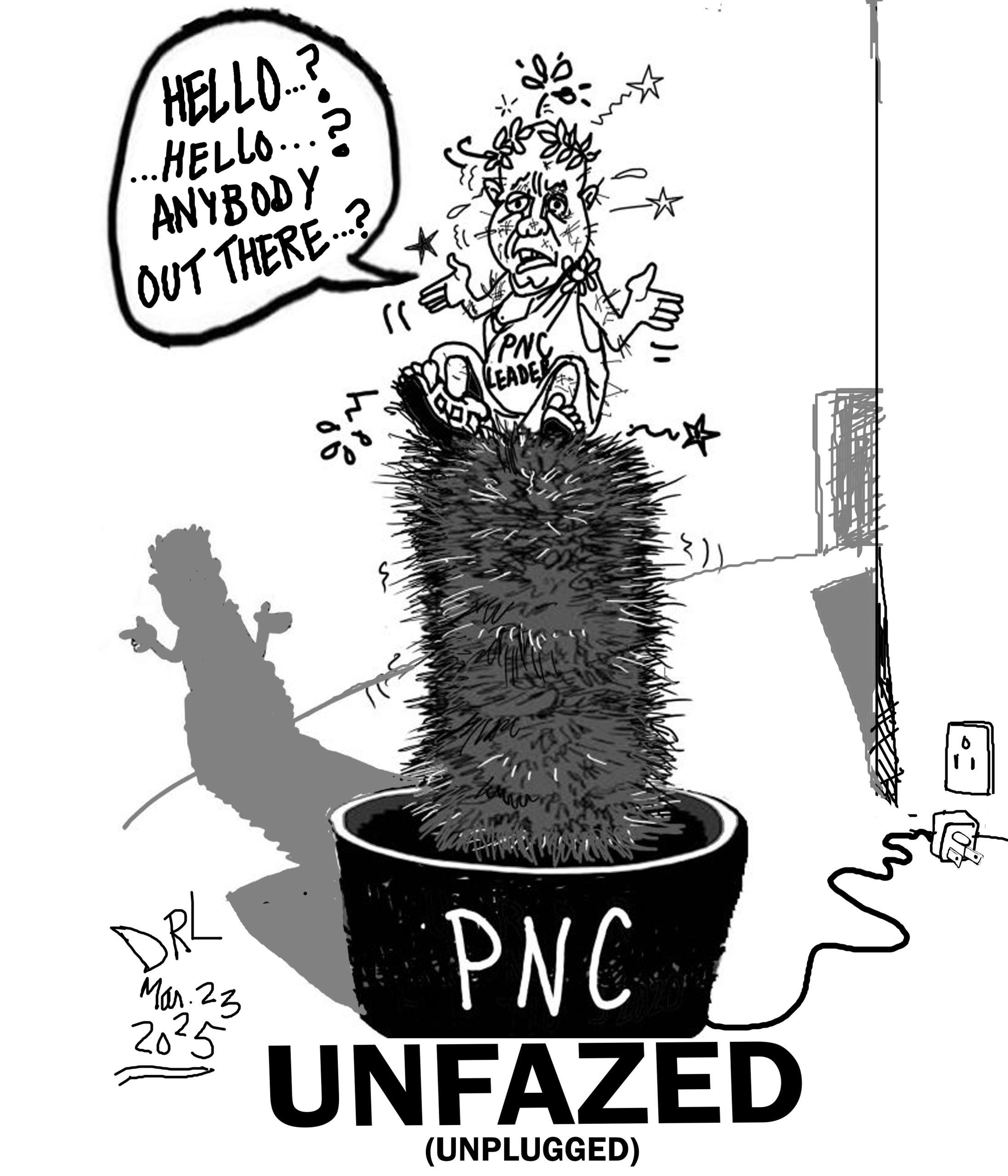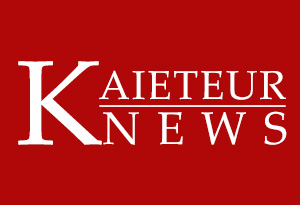Latest update March 28th, 2025 6:05 AM
Latest News
- “It will be a very bad day for Venezuelan if they attack Guyana or ExxonMobil”—Rubio declares
- Guyana gets info on U.S. tax evasion allegations against Mohameds, Mae Thomas
- US$35 injected into banking system to address foreign currency shortage—VP Jagdeo
- Citizens to stage protest today against lack of access to information in Guyana
- Guyana vows to stand with U.S.
Freddie’s sensationalist column was typically partial and unbalanced
Feb 11, 2013 Letters
Dear Editor,
Freddie Kissoon’s sensationalist column of 02-02-13, “In physics and dialectics, there is the concept of balance” was typically partial and unbalanced, which has contributed to his bane.
It is unfortunate that the Salem Church on Hadfield Street desecrated its hallowed halls by allowing Mr. Kissoon, an avowed atheist, to use their pulpit to fumigate hate in the country. And I wished I were a fly on the wall in the Bethel Congregational Church in Beterverwagting to hear what gospel Nigel Hughes and others were actualizing in that sacrosanct dwelling; (the word “Bethel” means ‘House of God’, or ‘the place where God dwells’)!
Mr. Kissoon is peeved that 98% of the faces found in ads were “either light in complexion, very white and are from people outside of the African ethnic mix”. It is farcical and absurd that the columnist was writing about ‘balance’ when his focus has consistently been only on the African side, which make up only 30% of the population. It would have been insightful if the researcher could have given us the percentage of faces (say, over the past 20 years) who were from the Amerindian ethnic mix, considering that they are 10% of the citizenry. And you’d think the now famous statistician would have given us comparative data for Indians, who comprise 43% of the population!
Mr. Kissoon is angry that almost all of the ads have light skinned persons, and has repeatedly expressed his disgust that Indians in India have been partial to those with lighter complexion in the Bollywood arena. (I share this sense of disgust, as it is true not only to actors, for also those in certain employment, for those looking for a spouse, etc.). But does he know that Africans, from Jamaica to South Africa use lightening creams to look lighter and non-black? A University of Cape Town study showed that one in three women in South Africa tries hard to whiten their skin to look white, including Local musician Nomasonto “Mshoza” Mnisi, who is now several shades lighter. The situation in Nigeria is worse, where approximately 77% of the women use skin lighteners. And many African women in the continent and in the diaspora, including Guyana, have used hair straighteners thereby departing from the traditional Bantu appearance.
In Jamaica, the most public proponent of bleaching is singing star Vybz Kartel , whose own complexion has dramatically lightened in recent years. His ‘Look Pon Me’ contains the lines: “Di girl dem love off mi brown cute face, di girl dem love off mi bleach-out face.” And residents of Denham Town, in west Kingston, say the introduction of a ‘new type’ of skin lightening cream has sparked fist fights and a rift among women in a section of their community. The women are reportedly accusing each other of spitefully purchasing too much of the commodity to get the other jealous.
On 13-01-13, the Stabroek News carried an article, “Fly Jamaica inaugural flight delayed”, and showed a photo of the attendant crew. There were eight women shown in the photo; except for one, all of them were light skinned, most with dyed hair! The bottom line is people in many parts of the world like to look lighter, and advertisers hone in on that axiom.
Mr. Kissoon again rouses, “Where is the balance in commerce, import-export trade, financial houses, land ownership, property ownership, investments in business ventures, agricultural projects, engineering firms, the construction industry, the retail trade in downtown Georgetown etc?” Ow bai, Freddie, where were all those things when the PNC held power for 28 years? Have the PPP, PNC, UF, or the colonial powers buckled down those of a particular ethnic background not to flourish in those areas mentioned?
Can you imagine dictating to advertisers or the Private Sector Commission that 10 percent of the ads should fall within the Amerindian “ethnic mix”, 30 percent to the Africans, 43 percent to the Indians, etc.?
The U.S. government interjected in their struggling economy billions of dollars not to help specifically ethnic groups; it did so to make it easier to help the struggling American. You provide grass for the horse to eat, but, as my Aggy used to say, “you can’t force haass to eat grass”!
Mr. Kissoon is petulant about the sizeable financial (Indian) ownership in the country. Why have Indians become more successful in business in Guyana, and elsewhere? Whether it is in Trinidad, Jamaica, the U.S., Canada, the U.K., Kenya or South Africa, the Indians have made their mark, and have done well in business. The eminent and consummate business acumen of Indians is universally known and is respected; their enterprising spirit and diligence (haad wuk) is reason for their success.
While some are asleep from their late night dance, they get up early in the morning and start to wuk haad to feed themselves and their families.
Mr. Kissoon reminds us “ if sections of a society are deprived, sensing gloom and doom, they tend to become desperate”.
“Desperate”, is what Idi Amin, the brutal dictator of Uganda, felt, and kicked out almost all the Indians out of the country in 1972 – about 75,000, as they had controlled 90% of the country’s economy. Now that the economy was in the hands of the Ugandans, what happened?
The economy was collapsing, so when Museveni seized power on January 26, 1986 he realized that perhaps the best way to revive Uganda’s persistent economic weakness was to call back the captains of industry. And these were the Indians. His efforts paid off as many of them returned and helped to give the country new hope.
More than 70% of the top taxpayers in Uganda are businesses owned or managed by Asians, contributing in excess of 65% of the domestic revenue. Approximately a million indigenous Ugandans are employed by Indian owned/managed businesses. Indians, who play a vital role in providing goods and services in the country, own many of the new corner stores and flourishing businesses on Kampala Road.
And what about business ownership and positions of Indians in the U.S.A., who comprise less than two percent of the population? The former lecturer might have belly ache to know that the Indian American median family income is $61,322 as against the national median family income of $41, 994.
The high income clearly reflects the advanced educational levels achieved by the community. Indians account for more than 15% of high-tech startups California’s Silicon Valley. It is mind boggling to think that 38% of doctors in the country are Indians; 36% of NASA scientists, 34% of Microsoft employees, and 28% of IBM staff are Indians.
And guess what, Freddie – approximately 37% of all hotels and motels in the U.S. are owned by Indians! How did/can it happen – because of haad wuk! These figures are staggering, keeping in mind that Indians are less than 2% of the citizenry? What if the U.S. population consisted of 43% as it is in Guyana?!
On an in-transit flight recently, I was struck to see that most of the employees at Heathrow airport seemed to be Indian, including those who were cleaners, the logistic staff, security guards, etc. (These jobs were obviously contracted, and the Indians won these contracts – not because of political or racial bias). So what account for success and ownership of Indians all over the world? Haad wuk – that’s the reason!
Speaking of dialectics, in my next letter, I shall protest lack of balance in Guyana’s national football and track-and-field teams!
Devanand Bhagwan
Share this:
- Click to print (Opens in new window)
- Click to email a link to a friend (Opens in new window)
- Click to share on Facebook (Opens in new window)
- Click to share on WhatsApp (Opens in new window)
- Click to share on Twitter (Opens in new window)
- Click to share on Pinterest (Opens in new window)
- Click to share on Pocket (Opens in new window)
- Click to share on Tumblr (Opens in new window)
- Click to share on Reddit (Opens in new window)
- Click to share on LinkedIn (Opens in new window)
Related
Similar Articles

The Glenn Lall Show|| March, 17th, 2025
Follow on Tik Tok @Glennlall
THE BLUNT OF THE DAY

Sports
Mar 28, 2025
-Milerock face Bamia, Hi Stars battle Botafago, Ward Panthers match skills with Silver Shattas Kaieteur News- With a total $1.4M in cash at stake, thirteen clubs are listed to start their campaign as...Features/Columnists
The PPP has started the intimidation
Peeping Tom… Kaieteur News- In politics, as in life, what goes around comes around. The People’s Progressive Party/Civic... more
The Caribbean: Destined to Grin and Bear the Consequences of Its Self-Created Vulnerabilities?
By Sir Ronald Sanders For decades, many Caribbean nations have grappled with dependence on a small number of powerful countries... more
Publisher’s Note
Freedom of speech is our core value at Kaieteur News. If the letter/e-mail you sent was not published, and you believe that its contents were not libellous, let us know, please contact us by phone or email.
Feel free to send us your comments and/or criticisms.
Contact: 624-6456; 225-8452; 225-8458; 225-8463; 225-8465; 225-8473 or 225-8491.
Or by Email: [email protected] / [email protected]
Weekend Cartoon















